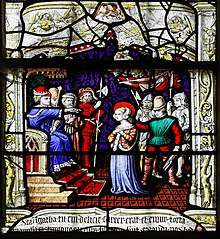Agatha of Sicily
Agatha[4] of Sicily (c. 231 – c. 251 AD) is a Christian saint. Her memorial is on 5 February. Agatha was born at Catania or Palermo, Sicily, and she was martyred in approximately 251. She is one of seven women, who, along with the Blessed Virgin Mary, are commemorated by name in the Canon of the Mass.[5]
Saint Agatha of Sicily | |
|---|---|
 Martyrdom of Saint Agatha | |
| Virgin and Martyr | |
| Born | c. 231[1] Catania or Palermo, Sicily |
| Died | c. 251 Catania, Sicily |
| Venerated in |
|
| Canonized | Pre-congregation by tradition confirmed by Pope Gregory I |
| Feast | February 5 |
| Attributes | shears, tongs, breasts on a plate[2] |
| Patronage | Sicily; bellfounders; breast cancer; bakers; Catania, Sicily; against fire; earthquakes; eruptions of Mount Etna; fire; jewelers; martyrs; natural disasters; nurses; Palermo, Sicily; rape victims; San Marino; single laywomen; sterility; torture victims; volcanic eruptions; wet nurses; Zamarramala, Spain,[3] |
She is the patron saint of Catania, Molise, Malta, San Marino, Gallipoli in Apulia,[6] and Zamarramala, a municipality of the Province of Segovia in Spain. She is also the patron saint of breast cancer patients, martyrs, wet nurses, bell-founders, bakers, and invoked against fire, earthquakes, and eruptions of Mount Etna.
Early history
Agatha is buried at the Badia di Sant'Agata, Catania.[7] She is listed in the late 6th-century Martyrologium Hieronymianum associated with Jerome,[8] and the Synaxarion, the calendar of the church of Carthage, ca. 530.[9] Agatha also appears in one of the carmina of Venantius Fortunatus.[10]
Two early churches were dedicated to her in Rome,[11] notably the Church of Sant'Agata dei Goti in Via Mazzarino, a titular church with apse mosaics of ca. 460 and traces of a fresco cycle,[12] overpainted by Gismondo Cerrini in 1630. In the 6th century AD, the church was adapted to Arianism, hence its name "Saint Agatha of Goths", and later reconsecrated by Gregory the Great, who confirmed her traditional sainthood.
Agatha is also depicted in the mosaics of Sant'Apollinare Nuovo in Ravenna, where she appears, richly dressed, in the procession of female martyrs along the north wall. Her image forms an initial I in the Sacramentary of Gellone, which dates from the end of the 8th century.
Life
One of the most highly venerated virgin martyrs of Christian antiquity, Agatha was put to death during the persecution of Decius (250–253) in Catania, Sicily, for her determined profession of faith.[8]
Her written legend[13] comprises "straightforward accounts of interrogation, torture, resistance, and triumph which constitute some of the earliest hagiographic literature",[14] and are reflected in later recensions, the earliest surviving one being an illustrated late 10th-century passio bound into a composite volume[15] in the Bibliothèque nationale de France, originating probably in Autun, Burgundy; in its margin illustrations Magdalena Carrasco detected Carolingian or Late Antique iconographic traditions.[16]
According to the 13th-century Golden Legend (III.15) by Jacobus de Voragine, fifteen-year-old Agatha, from a rich and noble family, made a vow of virginity and rejected the amorous advances of the Roman prefect Quintianus, who thought he could force her to turn away from her vow and marry him. His persistent proposals were consistently spurned by Agatha. This was during the persecutions of Decius, so Quintianus, knowing she was a Christian, reported her to the authorities. Quintianus himself was governor of the district.[18]
He expected her to give in to his demands when she was faced with torture and possible death, but she simply reaffirmed her belief in God by praying: "Jesus Christ, Lord of all, you see my heart, you know my desires. Possess all that I am. I am your sheep: make me worthy to overcome the devil." With tears falling from her eyes, she prayed for courage. To force her to change her mind, Quintianus sent Agatha to Aphrodisia, the keeper of a brothel, and had her imprisoned there. Agatha never lost her confidence in God.[19]
Quintianus sent for her again, argued, threatened, and finally had her imprisoned and tortured. She was stretched on a rack to be torn with iron hooks, burned with torches, and whipped. Amongst the tortures she underwent was the cutting off of her breasts with pincers. After further dramatic confrontations with Quintianus, represented in a sequence of dialogues in her passio that document her fortitude and steadfast devotion, Agatha was then sentenced to be burnt at the stake, but an earthquake saved her from that fate; instead, she was sent to prison where St. Peter the Apostle appeared to her and healed her wounds.[20]
Agatha died in prison, probably in the year 251 according to the Legenda Aurea. Although the martyrdom of Agatha is authenticated, and her veneration as a saint had spread beyond her native place even in antiquity, there is no reliable information concerning the details of her death.[8]
Osbern Bokenham, A Legend of Holy Women, written in the 1440s, offers some further detail.[21]
Veneration
According to Maltese tradition, during the persecution of Roman Emperor Decius (AD 249–251), Agatha, together with some of her friends, fled from Sicily and took refuge in Malta. Some historians believe that her stay on the island was rather short, and she spent her days in a rock-hewn crypt at Rabat, praying and teaching the Christian Faith to children. After some time, Agatha returned to Sicily, where she faced martyrdom. Agatha was arrested and brought before Quintanus, praetor of Catania, who condemned her to torture and imprisonment. The crypt of St. Agatha is an underground basilica, which from early ages was venerated by the Maltese. At the time of St. Agatha's stay, the crypt was a small natural cave which later on, during the 4th or 5th century, was enlarged and embellished.[22]
After the Reformation era, Agatha was retained in the calendar of the Church of England's Book of Common Prayer with her feast on 5 February. Several Church of England parish churches are dedicated to her.
Festival of Saint Agatha in Catania
The Festival of Saint Agatha in Catania is a major festival in the region, it takes place in the first five days of February. The Catania Cathedral (also known as Cattedrale di Sant'Agata) is dedicated to the saint.
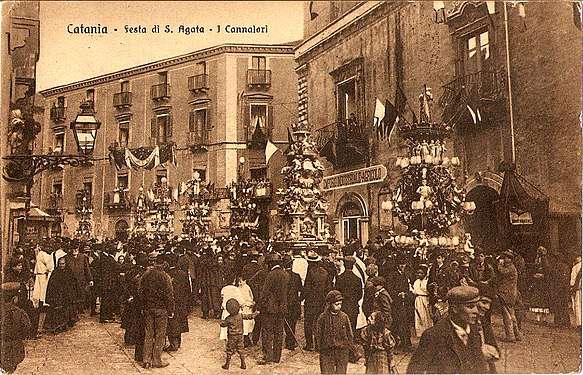 1915
1915.jpg) 2008
2008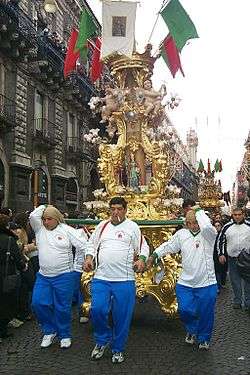 2007
2007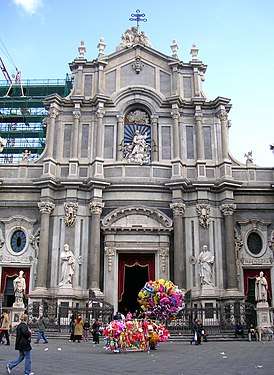 Catania's duomo during the festival
Catania's duomo during the festival
Patronage
Saint Agatha is the patron saint of rape victims, breast cancer patients, wet nurses, and bellfounders (due to the shape of her severed breasts). She is also considered to be a powerful intercessor when people suffer from fires. Her feast day is celebrated on February 5.
She is also a patron saint of Malta, where in 1551 her intercession through a reported apparition to a Benedictine nun is said to have saved Malta from Turkish invasion.[22]
She became the patron saint of the Republic of San Marino after Pope Clement XII restored the independence of the state on her feast day of February 5, 1740.[23]
She is also the patron saint of Catania, Sorihuela del Guadalimar (Spain), Molise, San Marino and Kalsa, a historical quarter of Palermo.
She is claimed as the patroness of Palermo. The year after her death, the stilling of an eruption of Mount Etna was attributed to her intercession. As a result, apparently, people continued to ask her prayers for protection against fire.[24]
In Switzerland Agatha is considered the patron saint of fire services.
Iconography

Saint Agatha is often depicted iconographically carrying her excised breasts on a platter, as in Bernardino Luini's Saint Agatha (1510–1515) in the Galleria Borghese, Rome, in which Agatha contemplates the breasts on a standing salver held in her hand.
The tradition of Agatha Buns, Agatha bread, or so-called St Agatha's Breasts or Minne di Sant'Agata (Italian/Sicilian for Breasts of St. Agatha) or Minni di Virgini (Italian/Sicilian for Breasts of (a) virgin), served or blessed on her feast day, is found in many countries. The small round fruit buns are iced and topped with a cherry, intended to represent breasts.[25][26]
Legacy
Basques have a tradition of gathering on Saint Agatha's Eve (Basque: Santa Ageda bezpera) and going round the village. Homeowners can choose to hear a song about her life, accompanied by the beats of their walking sticks on the floor or a prayer for the household's deceased. After that, the homeowner donates food to the chorus.[27] This song has varying lyrics according to the local tradition and the Basque language. An exceptional case was that of 1937, during the Spanish Civil War, when a version appeared that in the Spanish language praised the Soviet ship Komsomol, which had sunk while carrying Soviet weapons to the Second Spanish Republic.
An annual festival to commemorate the life of Saint Agatha takes place in Catania, Sicily, from February 3 to 5. The festival culminates in an all-night procession through the city.[28]
St. Agatha's Tower is a former Knight's stronghold located in the north west of Malta. The seventeenth-century tower served as a military base during both World Wars and was used as a radar station by the Maltese army.[22]
Saint Agatha in art
Agatha is a featured figure on Judy Chicago's 1979 installation piece The Dinner Party, being represented as one of the 999 names on the Heritage Floor.[29]
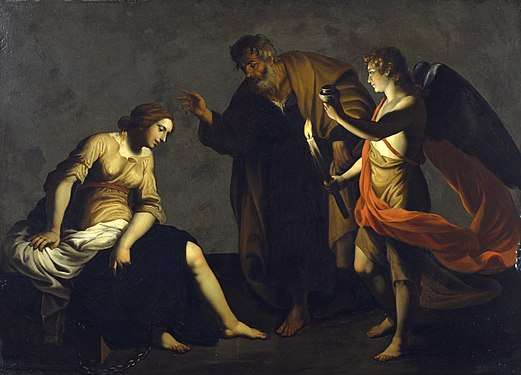 Alessandro Turchi, Saint Agatha Attended by Saint Peter and an Angel in Prison, The Walters Art Museum
Alessandro Turchi, Saint Agatha Attended by Saint Peter and an Angel in Prison, The Walters Art Museum.png) Saint Agatha, detail from a painting of Francisco de Zurbarán
Saint Agatha, detail from a painting of Francisco de Zurbarán Saint Agatha bearing her severed breasts on a platter, by Piero della Francesca (c. 1460–1470)
Saint Agatha bearing her severed breasts on a platter, by Piero della Francesca (c. 1460–1470)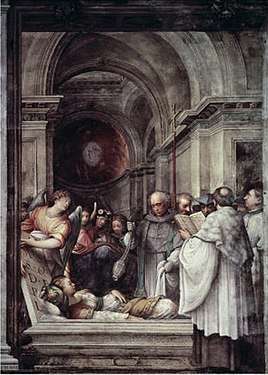 Burial of St Agatha, by Giulio Campi, 1537
Burial of St Agatha, by Giulio Campi, 1537 Saint Peter Healing Agatha, by the Caravaggio-follower Giovanni Lanfranco, c. 1614
Saint Peter Healing Agatha, by the Caravaggio-follower Giovanni Lanfranco, c. 1614 Saint Agatha virgin and martyr
Saint Agatha virgin and martyr
See also
- Incorruptibility
- List of Catholic saints
- Saint Agatha of Sicily, patron saint archive
- Santa Gadea, a church of historical importance devoted to Agatha, located in Burgos
References
- D'Arrigo, Santo. Il Martirio di Santa Agata (Catania) 1985
- Delaney, John P. (1980). Dictionary of Saints (Second ed.). Garden City, NY: Doubleday. ISBN 0-385-13594-7.
- "Saint Agatha", Catholic Culture
- Latinized form of Greek Ἀγαθή (Agathe), derived from Greek ἀγαθός, agathos, "good" (Behind the Name: the etymology and history of first names); Jacobus de Voragine, taking etymology in the Classical tradition, as a text for a creative excursus, made of Agatha one symbolic origin in ἅγιος agios, "sacred" and Θεός Theos, "God", and another in a-geos", "without Earth", virginally untainted by earthly desires ("Agatha", III.15).
- Attwater, Donald; John, Catherine Rachel (1993). The Penguin Dictionary of Saints (3rd ed.). New York: Penguin Books. ISBN 0-14-051312-4.
- The relics of S. Agata, in particular her breasts, were stolen, on orders of the saint herself, and brought to Gallipoli in 1126. She is the patron of the diocese of Gallipoli, the cathedral of Gallipoli, and of the city. Ravenna, Bartolomeo (1836). Memorie istoriche della città di Gallipoli (in Italian). Napoli: R. Miranda. pp. 316-326.
- D'Arrigo 1985, p. 15; the present rebuilding of the ancient foundation is by Giovanni Battista Vaccarini (1767).
- Kirsch, Johann Peter. "St. Agatha." The Catholic Encyclopedia. Vol. 1. New York: Robert Appleton Company, 1907. 25 Apr. 2013
- W.H. Frere, Studies in Roman Liturgy: 1. The Kalendar (London, 1930), p 94f.
- Carmen VIII, 4, De Virginitate, noted by Liana De Girolami Cheney, "The Cult of Saint Agatha" Woman's Art Journal 17.1 (Spring – Summer 1996:3–9) p. 3.
- Sant'Agata in via della Lugaretta, Trastevere, and Sant'Agata dei Goti, (Touring Club Italiano, Roma e dintorni [Milan, 1965], pp 444, 315).
- (date in TCI, Roma e dintorni; a letter from Pope Hadrian I (died 795) to Charlemagne remarks that Gregory (died 604) ordered the church adorned with mosaics and frescoes (Cheney 1996 note 5).
- Acta Sanctorum IV, February vol. I (new ed. Paris, 1863) pp. 599–662
- Magdalena Elizabeth Carrasco, "The early illustrated manuscript of the Passion of Saint Agatha (Paris, Bibl. Nat., MS lat. 5594)", Gesta 24 (1985), p. 20.
- The volume comprising texts of various places and dates was probably compiled when it was in the collection of Jean-Baptiste Colbert from which it entered the French royal collection.
- Carrasco 1985, pp. 19–32.
- Bey, Martine Callias; David, Véronique (2006). Les vitraux de Basse-Normandie. Rennes: Presses universitaires de Rennes. p. 157. ISBN 2-84706-240-8.
- "Agatha of Sicily", Saints Resource, RCL Benziger
- "Fabio, Michelle. "Feast of Saint Agatha in Catania, Sicily", Italy magazine, 2 February 2009". Archived from the original on 30 December 2012. Retrieved 25 April 2013.
- Stracke, J. R., "Saint Agatha of Sicily", Georgia Regents University, Augusta Georgia Archived August 13, 2009, at the Wayback Machine
- Osbern Bokenham, (Sheila Delany, tr.) A Legend of Holy Women (University of Notre Dame) 1992, pp. 157–167.
- "St. Agatha", St. Agatha's Crypt, Catacombs & Museum
- Nevio and Annio Maria Matteimi The Republic of San Marino: Historical and Artistic Guide to the City and the Castles, 2011, p. 23.
- Foley O.F.M., Leonard. Saint of the Day, (revised by Pat McCloskey O.F.M.), Franciscan Media ISBN 978-0-86716-887-7
- Illustration and details at Good Food Stories website.
- Reference with picture at Adventures of the Kitchen.
- J. Etxegoien, Orhipean, Gure Herria ezagutzen (Xamar) 1996 [in Basque].
- "Feast of Saint Agatha in Catania, Sicily", Italy magazine, February 2, 2009
- "Agatha". Elizabeth A. Sackler Center for Feminist Art: The Dinner Party: Heritage Floor: Agatha. Brooklyn Museum. 2007. Retrieved 17 December 2011.
External links
| Wikimedia Commons has media related to Agatha of Sicily. |
| Wikisource has original text related to this article: |
- "St Agatha - St Peter's Square Colonnades"
- "Here Followeth the Life of St. Agatha," from Jacobus Voragine, The Golden Legend, tr. William Caxton.
- "Saint Agatha of Sicily" at the Christian Iconography website
- Butler, Alban. The Lives of the Fathers, Martyrs and Other Principal Saints, Vol. I, D. & J. Sadlier, & Company, 1864
- "Saint Agatha Movie" at the Delusion website
- The Saint Agatha Virgin and Martyr Catholic Church" at the Nova Crnja municipality.
